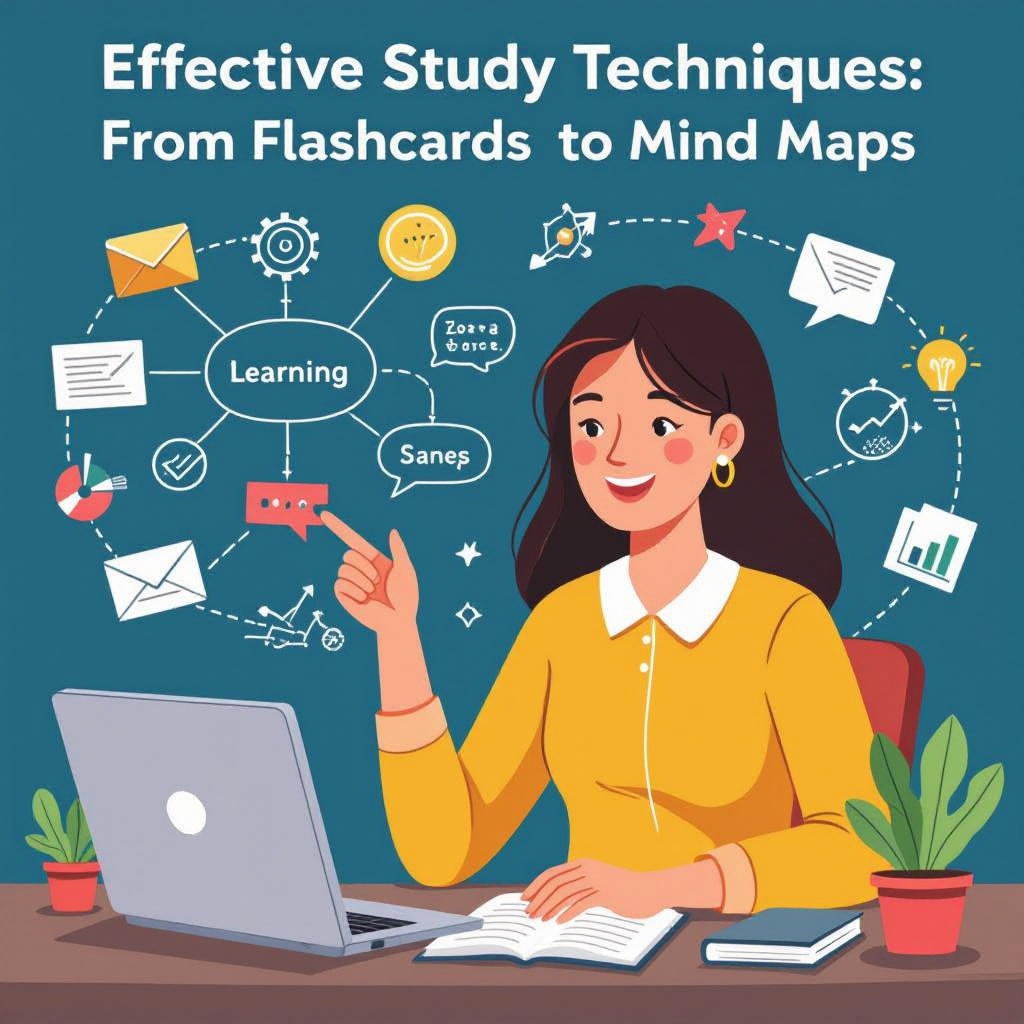Effective study techniques boost learning and retention, using tools like flashcards, mind maps, and spaced repetition. These strategies provide a full approach to mastering complex topics, improving both memory recall and understanding through structured and engaging study practices.
Key Takeaways
- Flashcards, paired with spaced repetition, boost memory retention significantly. They’re particularly effective for subjects like languages and history.
- Mind maps help organize complex ideas, supporting subjects such as science and math by improving understanding and visualization.
- Spaced repetition works with the forgetting curve, ensuring long-term retention by reviewing information at strategic intervals.
- Using flashcards and mind maps together offers a powerful learning approach, optimizing both memory and comprehension.
- Additional techniques like the SQ3R method and the Feynman technique enhance study efficiency by encouraging active engagement and recall testing.
Unlocking the Power of Flashcards
Flashcards offer a simplified method to boost memory retention and recall. They’re particularly effective for vocabulary acquisition, historical dates, and exams related to languages and history. To harness their full potential, incorporate spaced repetition. This technique, aligning with Hermann Ebbinghaus’s forgetting curve, involves reviewing information at increasing intervals. It’s a game-changer for retaining knowledge long-term.
Consider these strategies for subjects you’re tackling:
- Vocabulary Building: Create flashcards for new words, ensuring you review them progressively to cement them in your memory.
- Historical Dates: Write significant dates and events on cards, and revisit these regularly to reinforce timelines.
Strategic use of flashcards accelerates learning and retention. Don’t just cram information; spread the reviews over days or weeks. This method supports sustained knowledge retention, making your study sessions more productive.

Visual Learning with Mind Maps
Mind maps are a powerful tool for organizing and connecting ideas, especially when tackling complex topics. They’re perfect for brainstorming and strategic planning. Subjects like science and math benefit greatly from this technique. Handmade mind maps offer a tactile way to personalize your learning. Crafting your own map ensures less distraction and a more engaging connection with the material. They allow you to visually see links between ideas, promoting a deeper understanding.
Digital mind maps, on the other hand, bring a creative edge with a plethora of design choices. They’re ideal for those who enjoy a dynamic approach, providing features like hyperlinks and multimedia integration. Sharing becomes effortless with the option to collaborate in real time. This makes digital mind maps excellent for group studies and projects.
Collectively, both handmade and digital mind maps offer distinct advantages. Handmade maps foster personal engagement and focus, essential for deep, meaningful learning. Meanwhile, their digital counterparts provide flexibility, ease of access, and innovative features that cater to a tech-savvy approach. By choosing the right kind of mind map for your study needs, you enhance learning and ensure that complex topics become manageable and engaging.

Mastering Memory with Spaced Repetition
Spaced repetition hinges on the concept of the forgetting curve, which highlights how memory fades over time. By revisiting information at strategic intervals, this technique drastically boosts long-term memory retention. It proves invaluable in fields demanding frequent recall, like law and medicine. You can effectively use spaced repetition by reviewing flashcards at incrementally extended periods. This method ensures information is refreshed before it’s forgotten.
Practicality marks its significance. Law students might find it useful for remembering statutes, while medical students can keep vast medical terms top of mind. Platforms like Anki and SuperMemo automate this process. They predict the optimal time to review each piece of information. Such applications showcase this method’s adaptability across academic disciplines, enhancing retention rates significantly.

Synergizing Techniques for Enhanced Learning
Combining flashcards and mind maps boosts both memory and comprehension, especially for intricate subjects. To effectively integrate these methods, start by creating flashcards for foundational concepts. Use them to drill key terms and definitions until they’re ingrained.
Next, develop a mind map that interlinks these concepts, offering a visual representation of relationships and broader themes. Here’s how you can optimize your study session:
- Select key topics for your mind map.
- Use flashcards for each topic, solidifying basic details.
- Begin mapping with a central theme, branching out to related concepts.
- Connect your flashcards to sections of your map, reinforcing the links.
This approach not only makes information more manageable, but it also deepens comprehension. By alternating between quick recall with flashcards and big-picture visualization with mind maps, learning becomes a more dynamic and effective process.

Exploring Other Effective Study Techniques
For those keen on maximizing their study sessions, several other techniques can offer powerful results.
SQ3R Method
The SQ3R method involves Surveying the material, Questioning, Reading, Reciting, and Reviewing. This approach helps structure studying in a way that enhances understanding and memory retention. It encourages you to actively engage with the content instead of passively reading.
- Survey: Skim the material.
- Question: Formulate questions about the topic.
- Read: Dive into the content for thorough comprehension.
- Recite: Summarize what you’ve learned.
- Review: Go over the material regularly.
Retrieval Practice and Feynman Technique
Retrieval practice focuses on recalling information from memory to strengthen neural connections. By testing yourself instead of re-reading, you improve retention. The Feynman technique, named after physicist Richard Feynman, involves explaining concepts in simple terms. This method reveals gaps in understanding and consolidates learning. These strategies prove invaluable for any learning journey.
Sources:
Retain Cards – 6 Effective Learning Methods for Students
KeepMind AI – Not provided in the data
Mind Maker Academics – Study Techniques for Students 2025
InnerDrive – Handmade or Digital Mind Maps
University of St. Augustine for Health Sciences – Study Techniques
Memrizz – Flashcards vs Notes: The Study Battle That Will Change How You Learn
Crimson Global Academy – Top Exam Strategies for Students: Succeed in 2025 and Beyond

One Comment
[…] Choosing the best approach involves assessing these factors, ensuring that the strategy fits both the student’s personal comfort and the educational context. Every student should experiment with both techniques to discover what yields the best results for their learning process. […]